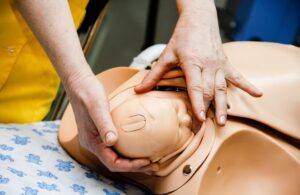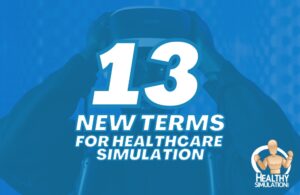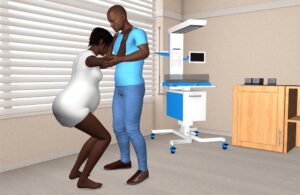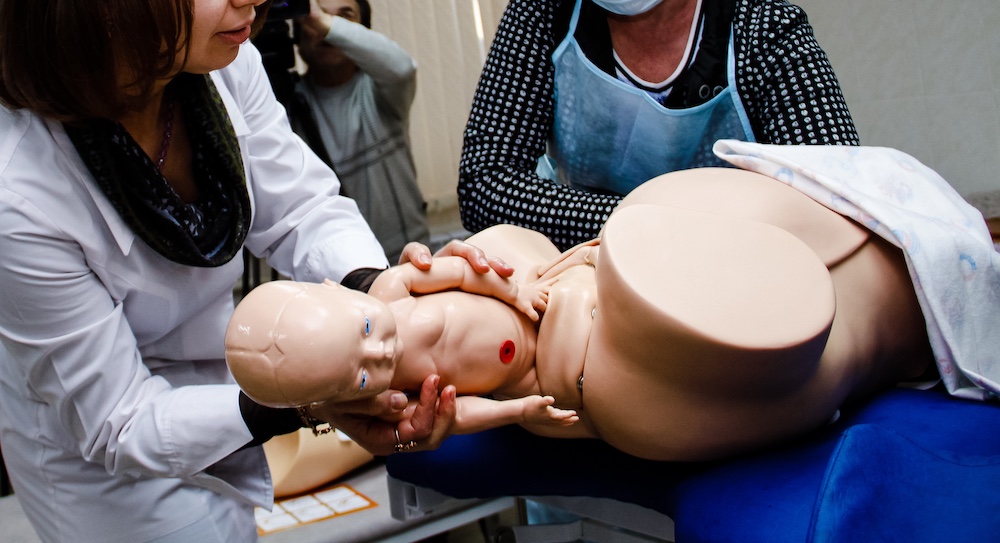Labor Simulator
A labor simulator is a lifelike patient Manikin used in Healthcare Simulation, which can realistically mimic a woman going through the process of labor and delivery. These complex Manikins can also be known as a childbirth simulator, Maternal Fetal simulator, Obstetric Simulator, birth simulator, or a birthing simulator. Healthcare professionals who focus on education and training should understand the high value of labor simulation for learners and their future patients, the technical aspects of labor simulators, and the various offerings available.
The Importance of Medical Training via Labor Simulation
According to the U.S. Centers for Disease Control and Prevention (CDC), in 2020, the infant mortality rate in the United States was 5.4 deaths per 1000 live births. This situates the United States as ranking 50th among all countries in 2020, according to data by UNICEF. Across the globe, even in developed countries, a surprising number of women die each year from conditions associated with childbirth, with a worldwide maternal mortality rate of 211 deaths per 100,000 live births, according to UNICEF. Although many deliveries and births occur without problems, there is work to be done to lower infant and maternal mortality rates—and much of this can be addressed directly through labor simulation.
Sponsored Content:
Labor simulation provides an opportunity for individual healthcare members and teams to practice the care of a mother and her newborn without any risk of harm to a mother or baby. Many labor simulator Manikins are controlled remotely by a technician with input from an educator, and special effects makeup called Moulage can be applied to make the simulated experience as accurate as possible.
This allows learners to practice making independent decisions in various real-life situations, which is especially important because many obstetric emergencies are low-frequency, high-risk events. Clinical Simulation gives obstetricians, midwives, nurses, and other healthcare personnel the opportunity to become efficient in responding to obstetric emergencies and to practice critical maneuvers that can save the mother’s or child’s life. In addition, by providing real-life experiences, labor simulators allow for teams to practice communication and team interactions. This is especially important because failure to communicate is one of the leading causes of medical errors.
Labor Simulators Help Learners Practice Responding to Obstetric Scenarios
Childbirth simulators can mimic labor problems, high-risk deliveries, and postpartum emergencies. For example, simulators can mimic a woman who labors for hours or who has comorbidities such as diabetes or high blood pressure (in obstetrics, this is often related to the condition of pre-eclampsia or eclampsia). Delivery can be programmed to present complications such as shoulder dystocia (a situation in which an infant’s shoulder becomes stuck on a mother’s pubic bone), babies with low Apgar scores, or placental abnormalities. Life-threatening postpartum conditions such as hemorrhage or cardiac arrest can also be simulated. The timing of the birth and opening of the cervix can also be altered to create various case studies. Labor simulators are often used for Nursing Simulation in nursing schools, and Medical Simulation in medical schools, as well as for advanced practice students who are studying obstetrics.
Sponsored Content:
Labor Simulators Come with a Variety of Different Offerings
Labor simulators range in complexity from a simple static model—which allows an operator to physically move a baby through the birth canal—to a fully-automated model that can deliver a baby with differing configurations. Some labor simulators also come with a baby Manikin that contains realistic characteristics such as cardiac and respiratory functions. This can help learners practice skills such as assessing Apgar scores and performing other immediate post-natal infant assessments. Other Manikins are wireless with no attached cables. This means the mother can deliver her baby in even the most unexpected places, which mimics many real-life situations.
Clinical Simulation Enables Repetition and Ease of Practice for Healthcare Learners
Healthcare educators have taken a page from the book of flight simulation training in aviation. Recognizing the benefits of learning via modeled scenarios, healthcare education has seen a huge expansion in the use of simulation in all areas. Although simple childbirth simulators have been around for a number of years, the use of Medical Simulation in a simulation center, particularly highly specialized birthing simulators, has increased significantly over the past 20 years.
Labor Simulators Contain Many Different Features to Enhance Realism
Manikins used in labor and delivery simulation can range from very basic to extremely realistic. Manikins that more closely resemble and mimic human physiology are known as “high fidelity Manikins,” and they are accurate enough that they can even be used in Surgery Simulation. Predictably, the more sophisticated the Manikin, and the more complex, the higher the cost.
At one end of the scale, a basic labor simulator may have a pelvis, birth canal, cervix, and baby with interchangeable parts that allow learners to visualize the standard steps in childbirth. This can be useful for certain educational settings, such as Nursing Simulation. At the other end of the scale, ultra-sophisticated Manikins may contain a combination of any of the following advanced features for Clinical Simulation:
- Wireless remote control
- Streaming audio
- Either prerecorded or transmitted from an educator in another room
- Cardiac function
- Heart rates and rhythms that are audible and show up on a monitor
- Blood pressure (a healthcare learner can visualize blood pressure on a monitor or auscultate with a cuff)
- Respiratory rise and fall of the chest
- Palpable pulses
- Dilating cervix
- Articulating joints
- Pupil dilation
- Accurate internal anatomy
- Palpable uterine contractions with monitor waveforms
- Oxygenation status of mother and baby fetal monitor with monitor display
- Anatomical holograms
- Newborn with heart rate, respiratory rate, umbilical cord, cyanosis
In addition to these features, many labor simulators have realistic enough anatomies to allow for healthcare learners to meaningfully practice obstetric procedures and scenarios, such as:
- Forceps application
- Vacuum extraction
- Episiotomies
- Cesarean sections (C-sections)
- Variable passage of baby in the birth canal, with the ability to show position on a monitor
- Complete or partial delivery of the placenta
- Contracted or boggy uterus
- Postpartum hemorrhage with copious amounts of fake blood
One of the most profound obstetric emergencies, cardiac arrest of the mother, can also be simulated on a labor simulator or on a separate high-fidelity Manikin. This can allow learners to get practice responding to an infrequent, but high-risk scenario so that they are prepared if they ever encounter this in clinical practice.
Click Here to Connect to Leading Healthcare Simulation Vendors
Labor Simulators are Available from a Number of Vendors
Advanced childbirth simulators are available from global corporations like Gaumard Scientific (Noelle, Victoria), Laerdal Medical (SimMom, PROMPT, or MamaNatalie), and CAE Healthcare (Lucina, LucinAR), just to name a few. Low- and mid-fidelity simulators are available from companies like Limbs & Things, Pocket Nurse, and more. There are also varying levels of high-fidelity patient Manikins in the categories of pediatric simulators and infant simulators.
An annual Healthcare Simulation conference like INACSL, IMSH (from SSH), or SimGHOSTS is a great place to connect with vendors and make a labor simulator acquiring decision on site. Healthcare educators with an immediate need for a realistic labor simulator to enhance their clinical training no longer need to wait for a conference. They can now use the “find vendor” form to connect with leading vendors.
Deciding which Manikin is Right for a Clinical Simulation Program
Choosing a Manikin should be determined by the desired learning outcomes and level of learners within a given program. Not every hospital or healthcare educational institution needs a high-end Manikin, nor can every institution afford a high-fidelity model. For example, an associate degree nursing program can benefit from a less expensive, simpler model that mimics the basics of childbirth and delivery. On the other hand, medical and surgical trainees may require a more advanced model to acquire the necessary skills. When shopping for a labor simulator, it’s also important to remember that birthing Manikins can provide technology, but educational theory and methodology should be the foundation and primary focus of any Simulation program.
Labor Simulator Education Latest News

A Two-Step Process for Choosing a Birthing Simulator

10 Additional Medical Simulation Keywords You Need to Know About

Virtual Medical Coaching Offers Childbirth and Midwifery VR Training Solution
Sponsored Content:














